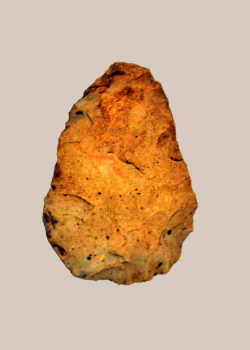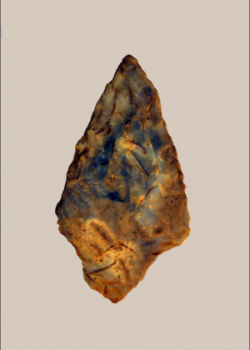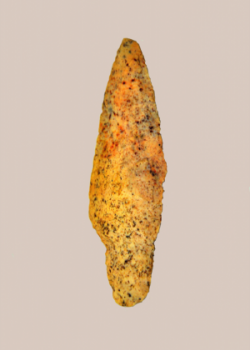
North American Late Woodland cultures
800-1100 C.E.
Pierson chert, amber variety, L. 4.9 cm x W. 7 mm x H. 6.9 cm
History Museum for Springfield-Greene County collection Panel 4

North American Early Woodland cultures
500-100 B.C.E.
St. David chert, Blair variety, L. 4.6 cm x W. 6 mm x H. 8.8 cm
History Museum for Springfield-Greene County collection Panel 11

North American Early Woodland cultures
1000-500 B.C.E.
Burlington chert, L. 2.8 cm x W. 8 mm x H. 6.7 cm
History Museum for Springfield-Greene County collection Panel 13
Native American stone points from the Ozarks region are often comparable to stone points in Mesoamerica, as although the type of stone may differ, similar points were often developed for similar purposes in different parts of the world. Comparison illustrates that the Ozarks’ Jack Reef Pentagonal Point, the Dickson Contacting Stem Point, and the Cressap Stemmed point are very similar, respectively, to the Absolo Point, the Gary Typical Point, and the Gary Long Point found among early Teotihuacano cultures in the Valley of Mexico.
Tool makers in Mesoamerica used different types of tool stone than did the tool makers of the Ozarks, because different resources and trade networks made different types of stone available. While Ozarks points are often made from fine-grained chert, Mesoamerican points are often made of obsidian, also known as volcanic glass–as there are active volcanoes in Mesoamerica. Nevertheless, the similar sizes and shapes of these points indicate that they were used for similar purposes. In general, the larger points would be used on spears and sometimes as knives, while the smaller points would be used on darts and arrows. Researched by Brenna Lightsey
For more information, you may contact the researcher(s) noted in the title of this exhibit entry, or Dr. Billie Follensbee, the professor of the course, at BillieFollensbee@MissouriState.edu

